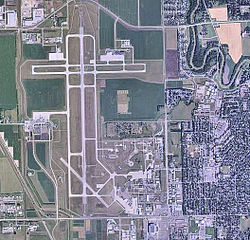Hector International Airport | |||||||||||||||||||
|---|---|---|---|---|---|---|---|---|---|---|---|---|---|---|---|---|---|---|---|
 | |||||||||||||||||||
 2006 USGS orthophoto | |||||||||||||||||||
| Summary | |||||||||||||||||||
| Airport type | Public / military | ||||||||||||||||||
| Owner | Municipal Airport Authority of the City of Fargo | ||||||||||||||||||
| Operator | Municipal Airport Authority | ||||||||||||||||||
| Serves | Fargo, North Dakota and Moorhead, Minnesota (Fargo–Moorhead) | ||||||||||||||||||
| Location | Fargo, North Dakota | ||||||||||||||||||
| Opened | 1927 | ||||||||||||||||||
| Hub for | |||||||||||||||||||
| Elevation AMSL | 901 ft / 275 m | ||||||||||||||||||
| Coordinates | 46°55′14″N 096°48′56″W / 46.92056°N 96.81556°W | ||||||||||||||||||
| Website | www.FargoAirport.com | ||||||||||||||||||
| Maps | |||||||||||||||||||
 FAA airport diagram | |||||||||||||||||||
 | |||||||||||||||||||
| Runways | |||||||||||||||||||
| |||||||||||||||||||
| Statistics (2023) | |||||||||||||||||||
| |||||||||||||||||||
Hector International Airport (IATA: FAR, ICAO: KFAR, FAA LID: FAR) is a civil-military public airport three miles (5 km) northwest of Fargo, in Cass County, North Dakota, United States. The busiest airport in North Dakota, it is owned by the City of Fargo Municipal Airport Authority.[2] Fargo Air National Guard Base is located adjacent to the airport.
The airport was named after Martin Hector, who first leased, and then donated the original 50 acres of land to the city.[3] Customs service is available for arrivals from Canada and other countries. Hector International has no scheduled passenger airline flights out of the country but has its international title (like many other airports) because of this customs service.
The airport is home to Fargo Air National Guard Base and the Happy Hooligans of the 119th Wing (119 WG), a unit of the North Dakota Air National Guard that operates the MQ-9 Reaper.
The airport was the intended destination for the airplane carrying Buddy Holly, Ritchie Valens, and J.P. Richardson on February 3, 1959. The airplane crashed shortly after takeoff from Mason City, Iowa, killing the three musicians and the pilot.
- ^ "2023 Year End Statistics For Fargo Airport". fargoairport.com. Retrieved February 5, 2024.
- ^ a b FAA Airport Form 5010 for FAR PDF, effective January 25, 2024
- ^ "Hector Field History". Municipal Airport Authority. Archived from the original on October 16, 2006.